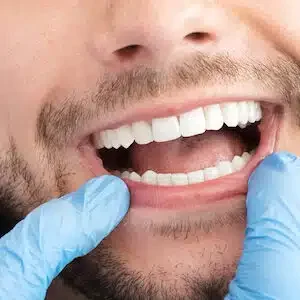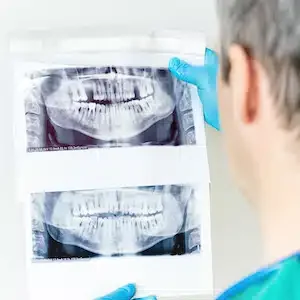BONE GRAFTING
Bone grafting is used to build up new bone in the area of your jaw that used to hold teeth
Bone Grafting for Dental Implant
What Is Bone Grafting, And Why May It Be Necessary Prior To A Dental Implant?
Bone grafting is a dental procedure that involves adding volume and density to your jaw. The loss of jaw bone can be due to a variety of reasons, including tooth extraction, gum disease, or trauma. A bone graft is often used to limit the amount of hard- and soft-tissue loss that occurs after a tooth extraction. Dr. Mike may advise that a bone graft is necessary to stabilize the jaw bone, and become a good dental implant candidate.
The need for a bone graft arises when the bone surrounding the missing tooth is weakened. This weakened area needs to be strengthened to provide adequate support for the dental implant, remaining teeth and surrounding tissues. Without sufficient bone, dental implant surgery may not be possible, or may lead to implant failure.
The bone graft procedure involves adding bone to the area where bone loss has occurred. This is typically performed by taking bone from another part of the patient’s body (autograft), or from a human tissue bank (allograft), or an animal tissue bank (xenograft). Once the bone graft procedure has been completed, the body’s natural healing process begins, and the grafted bone integrates with the existing bone. This creates a strong foundation for future dental work, such as dental implant surgery.
Four Types Of Dental Bone Grafts
Autograft
An autograft is a type of bone graft that involves taking bone tissue from one part of the patient’s own body, such as the chin, back of the jaw or hip, and transplanting it to the jaw bone where density is low. Autografts are considered the gold standard of bone grafts because the patient’s own bone is less likely to be rejected. It also contains bone-growing cells that increase the likelihood of successful bone healing. After having a tooth extracted, or is a tooth is missing due to another cause, it is important for the surrounding bone to be strong enough to support a dental implant.
Allograft
An allograft is a type of bone graft that involves using bone from a deceased donor. The bone tissue is thoroughly and carefully cleaned to reduce the risk of disease or bacterial transmission. Allografts are advantageous because the patient does not have to undergo another procedure to harvest bone.
Xenograft
A xenograft is a bone graft that uses bone material from an animal, typically a cow or pig. The underlying bone is carefully cleaned to reduce the risk of bacterial or disease transmission. Xenografts are less common than autografts and allografts, but they can be useful in cases where there is a limited amount of donor bone available.
Alloplast
An alloplast is a type of bone graft that involves using synthetic materials. These synthetic bone grafts are made from calcium phosphate or calcium sulfate, to create bone-like structures. This bone grafting material often used in cases where there is a limited amount of donor bone available.
Who May Need A Bone Graft Prior To Dental Implant Surgery?
A patient may need a dental bone graft prior to getting a dental implant if they have experienced loss of bone in the jaw. Dental implants require sufficient bone material to support them, so if there is not enough bone present, a bone graft may be necessary. A bone graft will add volume and density to the jaw in areas where bone loss has occurred. This loss of bone can occur due to a variety of reasons, including tooth extraction, gum tissue disease, or trauma. The degree of bone loss varies from patient to patient. Some patients may require a bone graft to ensure a successful dental implant placement, while others, with less bone loss may not require a bone graft at all.
Additionally, if a patient has active gum tissue disease, or a previous dental abscess or infection, they may already be experiencing some degree of bone resorption. Bone resorption can negatively affect natural teeth and require a bone graft prior to implant placement. Regular smokers are also more likely to require a bone graft due to the negative effects of smoking on bone health.
Is It Common To Need A Bone Graft Prior To Dental Implant Placement?
The answer is yes. Bone loss is a common occurrence and therefore a bone grafting is commonly needed prior to dental implant surgery. A bone graft may also be necessary prior to dental implant surgery if gum disease has affected the stability of a patient’s natural teeth.
Bone Graft Procedure
Before a bone graft procedure is deemed necessary
Prior to bone graft surgery, steps are taken to determine if the patient requires it. Dr. Mike will perform an oral exam to check the health of the patient’s teeth, gums, and jaw. Dental X-rays will be taken to determine the if bone loss exists and if so, the extent of bone loss. The results of the examination and imaging will provide Dr. Mike with the information he needs to determine the best course of treatment. Dr. Mike will then discuss the personalized treatment plan with the patient, and together a treatment plan will be finalized.
During bone graft surgery
Bone graft surgery is a surgical procedure that uses transplanted bone to repair and rebuild diseased or damaged bones. The process of bone graft surgery can vary depending on the specific case and the location of the bone that needs to be repaired. However, in general, the following steps are involved:
Anesthesia
Before the procedure, the patient will be given a local anesthesia to prevent pain and discomfort during the surgery. If necessary, a patient with a high level of anxiety can also be administered inhaled, oral or IV sedation. Patient comfort is of primary importance.
Incision
Dr. Mike will make an incision at the site of the damaged or diseased bone and between the neighboring teeth.
Preparation of the graft
Dr. Mike will then prepare the bone graft. The graft may come from the patient’s own body (autograft), a donor (allograft), a bovine animal (xenograft) or synthetic material (alloplast).
Placement of the graft
Dr. Mike will insert the bone graft into the site of the damaged or diseased bone. The graft may be secured with screws, wires, or pins.
Closure
Once the bone graft is in place, Dr. Mike will close the incision with stitches or staples.
Recovery
The recovery after bone graft surgery typically involves swelling, bruising, and some discomfort, which are normal side effects that should diminish in a few days. The healing process is straightforward, and the procedure is usually performed with a local anesthetic or light sedation. Gums may be sore after surgery due to a small incision made in the gum to place the graft. Patients may be given instructions to pack gauze around the incision, and how to change the dressing. Pain relievers and antibiotics may be prescribed, and the patient must take them exactly as directed. Overall, the recovery process may vary depending on the individual case, and it is important to follow the Dr. Mike’s post-operative instructions carefully to promote healing and to prevent complications.
Dental Implants After Bone Graft Surgery
Complete healing following dental bone graft surgery can take three to nine months, although patients will likely feel back to normal within a week or two. The duration of recovery time depends on several factors, such as the type of graft, the area where the graft was placed, and the individual’s healing capacity. In general, Dr Mike encourages patients to have a dental implant placed six to 12 months after a bone graft.
If you suffer from tooth loss or gum disease and would like to discuss dental implants with Dr. Mike, contact Cleveland Implant Institute today to schedule an appointment.
Request An Appointment
What Our Clients Are Saying
Dental Implant Services
Related Articles












